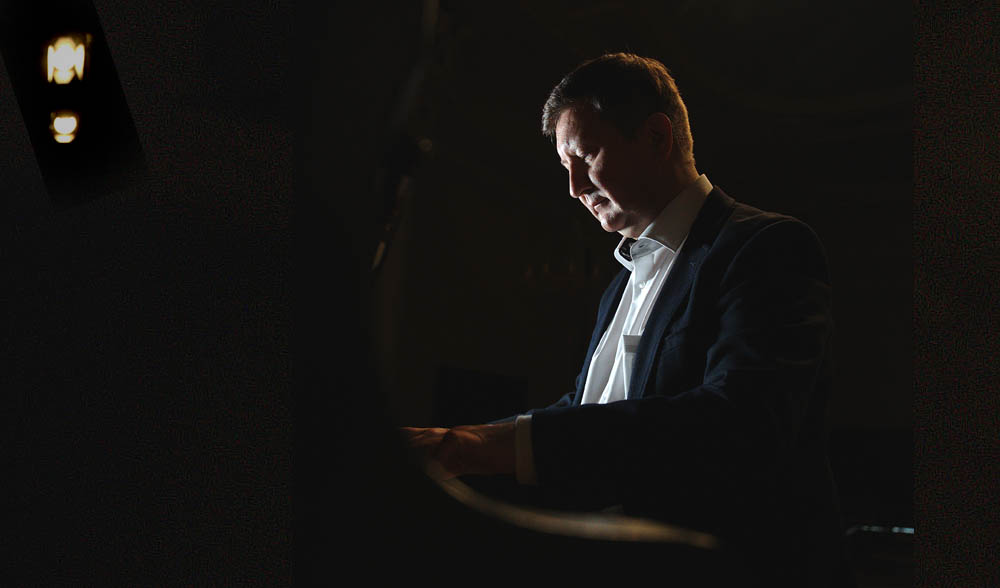Bio – English version (watch for a German version below)
The composer and pianist Boris Kosak studied musicology and composition at Kharkiw University of Arts with Valentin Bibik and Alexander Shchetynsky. 1994 Boris Kosak moved to Cologne where he studied composition with York Höller and electronic composition with Ulrich Humpert at the Music Univercity of Cologne. Simultaneously, he studied musicology as well as English and French philology at the University of Cologne.
Boris Kosak is an author of t h r e e s y m p h o n i e s (Sinfonia in G Nr. 1, Craftworks Symphony Nr. 2, and Vienna Symphony Nr. 3), two piano concertos („Il Carnevale die Colonia“ and „Four Seasons“), a violin concerto „Concerto in stile coloniale“, a cello concerto („BarCellona concerto“), and monumental „Mozart Variations“ for orchestra. His newest orchestra work is the symphonic poem „Ukraïna“ (2022).
These works testify a mature master of the orchestra score and they were celebrated in concert halls all over the world: in Germany, France, The Netherlands, Russia, Italy, Spain, Poland, Romania, Bulgaria, USA, Brasil, Australia, China, and South Korea. For his original creative style and the highest quality of work, Boris Kosak is recognized as one of the most innovative musical talents of the contemporary generation who left a deep trail with his exciting and melodic scores, always winning a stunning applause and a sheer enthusiasm of the audience.
A special predilection for the Baroque tradition inspired several compositions reviving concerto grosso („King Arthur’s Table Music“ ) and instrumental suite, most of the last consisting of one-minute pieces like 25 „Amuse-bouches“ for piano, 25 „Petit-fours“ for violin and piano, 14 „Dim Sum“ for piano, 36 „Momenti intimi“ for violoncello and piano, and 25 „Bagatelles essentielles“ for viola and piano.
2019 appeared the opera „Störtebecker and Jödge Michaels“, inspired by the Reinhard Keiser’s lost work, based on the original libretto from 1701 and composed completely new in an authentical style of the epoch.
Several albums with music by Boris Kosak were published in Germany, Austria, and South Korea. In the last years Boris Kosak has increasingly dedicated himself to neoclassical music for piano, performed by the composer himself or in a piano duo with reknown Hamburg pianist Alina Kabanova. As a result two albums have been published so far: „Beyond Silence“ and „All the Colors of Love“, the last one at Austrian Gramophone (Austria) and Stomp Music (South Korea).
2016 Boris Kosak moved the center of his creative activities to Hamburg.
Bio – German version
Der Komponist und Pianist Boris Kosak studierte Musikwissenschaft und Komposition am Kharkiwer Universität der Künste (Ukraine) bei Valentin Bibik und Alexander Shchetynsky. 1994 zog Boris Kosak nach Köln, wo er an der Musikhochschule Köln Komposition bei York Höller und elektronische Komposition bei Ulrich Humpert studierte. Parallel dazu studierte er Musikwissenschaft sowie Anglistik und Französische Philologie an der Universität zu Köln.
Boris Kosak ist Autor von d r e i S y m p h o n i e n (Sinfonia in G Nr. 1, Craftworks Symphony Nr. 2 und Wiener Symphonie Nr. 3), zwei Klavierkonzerten („Il Carnevale die Colonia“ und „Four Seasons“), einem Violinkonzert „Concerto in stile Coloniale“, ein Cellokonzert („BarCellona concerto“) und monumentale „Mozart-Variationen“ für Orchester. Sein neustes Orchesterwerk ist die sinfonische Dichtung „Ukraïna“ (2022).
Diese Werke bezeugen einen reifen Meister des Orchesters und wurden in Konzerthallen auf der ganzen Welt gefeiert: in Deutschland, Frankreich, Niederlande, Russland, Italien, Spanien, Polen, Rumänien, Bulgarien, USA, Brasilien, Australien, China, und Südkorea. Für seinen originellen kreativen Stil und die höchste Qualität der Werke gilt Boris Kosak als einer der innovativsten zeitgenössischen musikalischen Talente, die mit ihren spannenden und melodischen Partituren einige tiefe Spuren hinterlassen. Die leidenschaftliche Begeisterung seines Publikums schlägt sich regelmäßig in ausgiebigem Beifall nieder.
Eine besondere Vorliebe für die barocke Tradition inspirierte mehrere Kompositionen, die das Concerto grosso („King Arthur’s Table Music“) und die Instrumentalsuite wiederbeleben, von denen die meisten aus einminütigen Stücken bestehen, wie die 25 „Amuse-bouches“ für Klavier, die 25 „Petit-fours“. “ für Violine und Klavier, die 14 „Dim Sum“ für Klavier, die 36 „Momenti intimi“ für Violoncello und Klavier und die 25 „Bagatelles essentielles“ für Viola und Klavier. Die synästhetischen Verbindungen haben dabei die traditionellen Tanzrhythmen der Barocksuite deutlich erweitert.
2019 erschien die Oper „Störtebecker und Jödge Michaels“, inspiriert durch das verschollene Werk Reinhard Keisers, basierend auf dem Original-Libretto von 1701 und im authentischen Stil der Barockepoche völlig neu komponiert.
Mehrere Alben mit Musik von Boris Kosak wurden in Deutschland, Österreich und Südkorea veröffentlicht. In den letzten Jahren hat sich Boris Kosak zunehmend der neoklassischen Musik für Klavier verschrieben, aufgeführt vom Komponisten selbst oder im Klavierduo mit der renommierten Hamburger Pianistin Alina Kabanova. Als Ergebnis wurden bisher zwei Alben veröffentlicht: „Beyond Silence“ und „All the Colours of Love“, das letzte bei Austrian Gramophone (Österreich) und Stomp Music (Südkorea).
2016 ist Boris Kosak nach Hamburg gezogen, wo er als freischaffender Künstler tätig ist.


